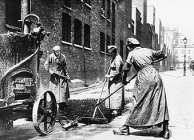The First World War accentuated the divisions between the left and right in the labour movement. The militancy of labour's rank and file continued unabated, whilst the exigencies of war gave labour's leaders the chance to become fully enmeshed within the State itself. The gulf between the two widened to such an extent that it was difficult for both to co-exist within the same organisations. The 'unofficial' opposition, reflecting the chasm between leaders and led, generated its own structures in the form of the Shop Stewards Movement and Workers' Committees. The shop stewards of today can trace their origins to this wartime period, during which rank and file workers kept effective trade unionism alive in the face of their leaders' preoccupation with the war effort.
Support for war
The resolutions of the Second International, in condemning colonialism (1907 Stuttgart Congress) and calling for workers to oppose war (1910 Copenhagen Congress), were promptly forgotten in the rush to arms and the International itself collapsed.
British labour leaders maintained an anti-war stance up until the point, on August 4th 1914, that the government finally declared war on Germany. By the end of August, the Labour Party and the TUC declared an 'industrial truce' for the duration of the war and lent their support to an all-party recruitment campaign. By May 1915, there were three Labour MP's in the Coalition Government, one of them, Arthur Henderson, in the cabinet. The two Treasury Agreements signed by government and trade union representatives confirmed labour's promise to abandon strike action for the duration of the war. It also drew the unions (including the Amalgamated Society, whose members were principally affected) into agreeing to suspend 'restrictive practices' in skilled trades by agreeing to the use of unskilled or semi-skilled labour (particularly that of women) in the war industries. (This was known as 'dilution'.)
Anti-war movement
The Independent Labour Party, however, maintained an anti-war policy from the start, even though some of its leading parliamentary members did not.
In addition, there was a considerable body of political opposition to the war which generated a host of anti-war organisations like the Union of Democratic Control and the No Conscription Fellowship. As the war progressed the lack of war aims coupled with the blundering of the military commanders, made it clear that the price of victory was to be paid through mass slaughter. Conscription was introduced in 1916.
'Red' Clyde
Whether consciously anti-war or not, it was clear from 1915 that industrial workers were not going to be cowed by the legal strictures against strike action. An early example of this mood of defiance came from the strike by engineering workers in munitions factories on the Clyde in 1915. The strike was, of course, unsupported by the ASE leadership. Aided by the hastily formed Central Labour Witholding Committee, the strike spread rapidly throughout the Clyde. Signs of mass defiance were not limited to Scotland. The strikes were ultimately defeated. However, on Clydeside, the Central Labour Witholding Committee was replaced by a permanent organisation - the Clyde Workers' Committee (CWC), whose chairman, William Gallacher was a member of the British Socialist Party.
The CWC provided the model for similar organisations in other urban industrial centres. Its language was syndicalist, but its practice was not - in the sense that it sought to link the industrial struggle (based on the shop stewards) with wider community based campaigns.
Shop Steward & Workers' Committee Movement
'Red Clyde' was in the vanguard of the wartime workers' movement, but mass protests led by revolutionary socialists developed with as much force in other parts of the country. The election of shop stewards and the formation of shop stewards committees was commonplace in most large factories which had been turned over to war time production. In Sheffield a Workers' Committee under the leadership of J.T.Murphy was formed on the model of the CWC. Other industrial centres like Manchester, London and later Birmingham also had Workers' Committees, but they were less long lived than their Sheffield and Clyde counterparts.
Women trade unionists
Women's trade union membership increased by about 160% during the war, but apart from the National Federation of Women Workers, the Workers' Union (WU) was the only union to make a serious commitment to organising women. By 1918 the WU employed twenty women full time officials and had a female membership of over 80,000. This was more than any other general union and represented a quarter of the WU's own membership. In 1918 the Equal Pay strike was led and ultimately won by women tramway workers - starting in London and spreading to other towns.
In 1914, the Women's Social and Political Union abandoned the suffrage campaign itself and ardently supported the war effort and urged all women to do the same. Sylvia Pankhurst's organisation was one of the very few to maintain the fight for the vote until its first instalment (to women over 30) was granted in 1918. The National Council for Adult Suffrage also kept up the pressure for the vote in the war years. This organisation was established in 1916 and held its first meeting at the Daily Herald offices. It was a broad based activist adult suffrage campaigning group linking the left wing of the women's movement with the left wing of the labour movement.
Professor Mary Davis, Centre for Trade Union Studies, London Metropolitan University
Back to top







